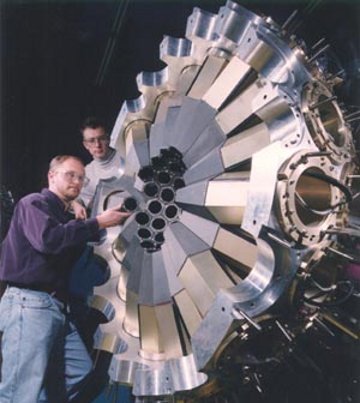The chemical element nobelium is classed as an actinide metal. It was discovered in 1966 by research scientists at the Joint Institute for Nuclear Research in Dubna.

Data Zone
| Classification: | Nobelium is an actinide metal |
| Color: | |
| Atomic weight: | (259), no stable isotopes |
| State: | solid |
| Melting point: | |
| Boiling point: | |
| Electrons: | 102 |
| Protons: | 102 |
| Neutrons in most abundant isotope: | 157 |
| Electron shells: | 2,8,18,32,32,8,2 |
| Electron configuration: | [Rn] 5f14 7s2 |
| Density @ 20oC: |
Reactions, Compounds, Radii, Conductivities
| Atomic volume: | – |
| Structure: | – |
| Hardness: | – |
| Specific heat capacity | – |
| Heat of fusion | – |
| Heat of atomization | – |
| Heat of vaporization | – |
| 1st ionization energy | 642 kJ mol-1 |
| 2nd ionization energy | – |
| 3rd ionization energy | – |
| Electron affinity | – |
| Minimum oxidation number | 0 |
| Min. common oxidation no. | 0 |
| Maximum oxidation number | 3 |
| Max. common oxidation no. | 3 |
| Electronegativity (Pauling Scale) | 1.3 |
| Polarizability volume | 17.5 Å3 |
| Reaction with air | |
| Reaction with 15 M HNO3 | |
| Reaction with 6 M HCl | |
| Reaction with 6 M NaOH | |
| Oxide(s) | |
| Hydride(s) | – |
| Chloride(s) | |
| Atomic radius | – |
| Ionic radius (1+ ion) | – |
| Ionic radius (2+ ion) | 105 pm |
| Ionic radius (3+ ion) | – |
| Ionic radius (1- ion) | – |
| Ionic radius (2- ion) | – |
| Ionic radius (3- ion) | – |
| Thermal conductivity | – |
| Electrical conductivity | – |
| Freezing/Melting point: | – |
Discovery of Nobelium
Research scientists at the Joint Institute for Nuclear Research in Dubna, Russia synthesized nobelium for the first time in 1966.
The element was given its name in honor of Alfred Nobel.
‘Nobelium’ had actually been proposed as the element 102’s name in 1957, by scientists from the Nobel Institute of Physics in Sweden who believed they had produced it. Further investigations ruled out the possibility they had made nobelium.
A stronger claim to have made nobelium was made in 1958 by scientists at the University of California, Berkeley.
After reviewing all claims IUPAC (International Union of Pure and Applied Chemistry) ruled that the discovery was most likely to have been made in Dubna in 1966.
Appearance and Characteristics
Harmful effects:
Nobelium is harmful due to its radioactivity.
Characteristics:
Nobelium is a synthetic, highly radioactive metal that has only been produced in miniscule amounts.
Nobelium is normally a divalent ion in aqueous solution. (1)
Uses of Nobelium
Nobelium is of scientific research interest only.
Abundance and Isotopes
Abundance earth’s crust: nil
Abundance solar system: –
Cost, pure: $ per g
Cost, bulk: per 100g
Source: Nobelium is a synthetic element and is not found naturally.
Nobelium is created by nuclear bombardment, and has only been produced in miniscule amounts. Nobelium can be produced by irradiating a californium-249 target with carbon-12 ions. (1)
Isotopes: Nobelium has 12 isotopes whose half-lives are known, with mass numbers 250 to 262.
Nobelium has no naturally occurring isotopes. Its longest lived isotopes are 259No with a half-life of 51.5 minutes, 255No, with a half-life of 31.8 minutes and 253No with a half-life of 1.7 minutes.

References
- Robert J. Silva, The Chemistry of the Actinide and Transactinide Elements., Springer., Vol 3.13, p1637-1639.
- Gammasphere.
Cite this Page
For online linking, please copy and paste one of the following:
<a href="https://www.chemicool.com/elements/nobelium.html">Nobelium</a>
or
<a href="https://www.chemicool.com/elements/nobelium.html">Nobelium Element Facts</a>
To cite this page in an academic document, please use the following MLA compliant citation:
"Nobelium." Chemicool Periodic Table. Chemicool.com. 08 Oct. 2012. Web. <https://www.chemicool.com/elements/nobelium.html>.
